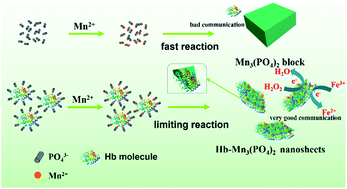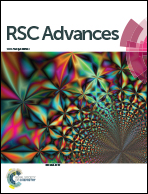In situ synthesis and analytical investigation of porous Hb–Mn3(PO4)2 hybrid nanosheets and their biosensor applications
Abstract
The excellent selectivity and anti-interference ability of enzyme-based biosensors have attracted considerable attention by researchers. However, the short lifetime, difficult electron transfer, and easily leak from the supporting materials restrict the practical applications of enzyme. In this study, an enzyme–inorganic hybrid biosensor constructed from slack Hb–Mn3(PO4)2·3H2O nanosheets was prepared by a simple and effective in situ immobilization method. Designed as an H2O2 sensor, it exhibits a fast electron transfer rate constant (ks = 4.16 s−1), an ultra-wide linear range for H2O2 detection (20 to 56 100 μM), and long life-time (85% of initial response after 29 days), which may be attributed to the effective immobilization of the enzyme and the good biocompatibility of Mn3(PO4)2·3H2O. For the detection of a real sample, the range of recovery of our designed biosensor was around 98.2–102.6%, confirming that our proposed method presents a promising immobilization enzyme-based biosensor for use in practical applications.


 Please wait while we load your content...
Please wait while we load your content...